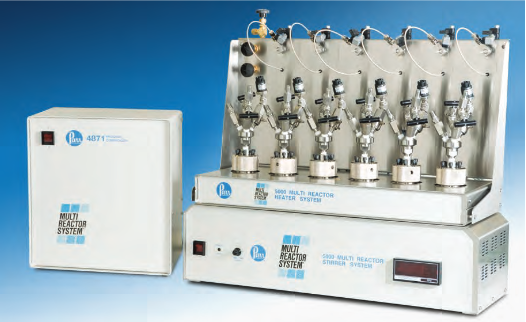
The Parr Series 5000 Multiple Reactor System has been designed to provide an integrated system for running multiple reactions simultaneously and applying the principles of high throughput experimentation to reactions conducted at elevated temperatures and pressures.
The principal features of the 5000 System include:
• Six reactors with internal stirring.
• Operating pressures to 3000 psi.
• Operating temperatures to 300 °C.
• Individual temperature control.
• Continuous individual pressure monitoring.
• Computer control and data logging.
• Manifold system for rapid turn around and to allow two different input gases.
• Volumes and reactor geometry designed for three phase reactions.
• Flexible Control Software.
Stirred Batch Reaction Vessel
This multiple reaction system has been designed around a vessel with 75 mL total volume. This will accommodate between 15 mL and 40 mL of liquid reactants which is close to the minimum volume appropriate for heterogeneous catalytic reactions.
The vessel valves and accessories are designed for maximum operating pressures up to 3000 psi at operating temperatures up to 300 °C. A system with 45 mL vessels is also available.
Stirring System
All six vessels are stirred with a single magnetic stirrer system specifically designed and built for this application. The magnetic drives and fields are focused on the stirrer bars within each vessel. High strength compact magnets are used to provide coupling forces which will operate through the heaters and vessels. The stirring speed of the stirrer bar is variable from 0-1200 rpm. All vessels will have the same stirring speed during a single run of the apparatus.This arrangement ensures that the difference in reaction rates between vessels run in parallel are due to set conditions other than variations in stirrer speed.
Heaters
The external heaters surround the vessel walls for rapid and uniform heating and temperature control. Each vessel is individually temperature controlled. The 250-watt heater used on each vessel produces heating rates up to 15 °C per minute. An optional reactor cooling support rack is available fo air-cooling.
Operating Modes
The Series 5000 Multiple Reaction System provides an apparatus for running up to six reactions in parallel to build a database for comparing and optimizing operating conditions.
The user can design experiments to:
• Run all reactions at the same temperature and pressure while varying catalyst loading or reactant concentrations to optimize these parameters.
• Run all reactors with identical loads varying pressures at a common temperature to study the effect of pressure on reaction rates.
• Run individual reactors with individual load ing and temperature and pressure to screen multiple options for activity.
A comparison of the plots of pressure drop versus time within the reactors running under parallel conditions will usually be the most useful means of measuring reaction rates and comparing operating conditions. The internal thermocouple also provides a means of detecting temperature changes due to exothermic reactions.
Reactor Options
As Parr customers have come to expect with our line of laboratory pressure reactor equipment, these reactors are offered with a number of options which permit the user to configure the system to their reactions and intended operating conditions.
These options include:
O-ring or Flat Gasket Seals. Vessels with O-ring seals are closed by simply tightening the screw cap down hand tight. The maximum operating temperature will depend upon the O-ring material. When equipped with FKM (Viton®) O-rings operating temperatures up to 225 °C are permitted. By substituting FFKM (Kalrez®) O-rings this limit can be raised to 300 °C. Careful consideration of chemical compatibility must also be given when selecting O-ring materials. PTFE gaskets can be used to temperatures up to 300 °C and offer virtually universal chemical compatibility. Six compression bolts are used to develop the sealing forces on the PTFE gaskets in this design.
Head Configuration.
Each reaction vessel is equipped with an inlet valve, exhaust valve, safety rupture disc, and pressure transducer in addition to an internal thermocouple. Vessels can be modified to include a dip tube for liquid sampling or a cold finger for cooling. The user can choose to have the valves, transducer and rupture disc mounted on a gage block connected directly to the vessel head, or remotely mounted on the back panel.
– Head Mounted. The head mounted design makes it possible to remove the pressurized vessels from the heater/stirrer assembly or to prefill the vessels in a remote location. PEEK flexible tubing with a quick slip connector is provided for each vessel for inlet of gas. Tubing is easily removed after gas fill.
– Panel Mounted. The remote panel mounted arrangement connects all the pressure inlets/ outlets to each vessel with a single PTFE lined stainless tubing. Alternate stainless steel tubing is offered if required. In the panel mount valve configuration the gas inlet tubing generally remains attached to the vessels during operation.
Materials of Construction.Typ e 316 Stainless Steel is the standard material of construction for both the vessel with its wetted parts and the gage block assemblies exposed to vapors. For investigators working with systems containing strong mineral acids or other more corrosive systems these vessels can be made of most of the Parr standard materials of construction.
Stirrer Configuration. Stirring is accomplished by use of either PTFE coated or glass coated magnetic stirrer bars.
Thermocouple Configuration. Thermocouples are mounted inside the vessel for the best temperature monitoring and control. The thermocouples are protected by stainless steel sheaths which are inserted into a protective thermowell. These thermowells make it easy to install and remove thermocouples from the vessels, and also provide additional chemical and mechanical protection for the thermocouple. We also offer an external thermocouple option with the thermocouples positioned in contact with each cylinder wall.
Gas Manifold. The brass gas inlet manifold is designed to handle both a purge gas, usually nitrogen, and a reactant gas, usually hydrogen. This can be set up to automatically fill each vessel to the same initial pressure or to manually fill each vessel to a unique operating pressure. This gas manifold can also be supplied in T316SS to meet more corrosive requirements.
Please note that we can use any Parr General Purpose for your customization need, for the option of Parr General Purpose Reactor, Click Here.
| Series Number | 5000 |
| Type | Bench Top Multiple Reactor |
| Vessel | Movable |
| Sizes | 45 ml & 75 ml |
| Maximum Operating Pressure | 3000 psi (200 bar) |
| Maximum Operating Temperature | 225 °C with FKM O-ring 300 °C with FFKM O-ring 350 °C with PTFE Flat Gasket |
For more information and specification, Click Here.
Parr designs and builds custom multiple reactor systems for use in combinatorial chemistry and high-throughput screening. These systems are based on our wide range of reactor systems and feature overhead magnetic drive stirrers. Contact us Here for details and proposals for custom multiple reactor systems.
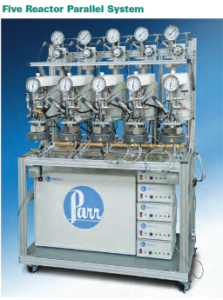
|
Five Reactor Parallel System incorporates five 160 mL, 4560 Series Stirred Mini Reactors rated for use at 350 °C and 3000 psig / 200 bar. Each of the reactors has a dedicated high pressure (5000 psig / 345 bar) 100 mL general purpose vessel associated with it serving as a reactant gas feed reservoir. These feed vessels are located above and immediately behind the main reactors and are each equipped with a dedicated pressure transducer, thermocouple and a constant pressure regulator. The regulator maintains the downstream reactor at a constant pressure while the pressure transducer/thermocouple combination allows the process controller to accurately monitor and record the real-time consumption of reactant gas. This system would normally be used to study various aspects of hydrogenation or carbonylation reactions. The 4871 Process Controller also controls and records the reactor temperature, stirring speed and monitors the reaction pressure. The compact reactor system stand incorporates not only reactant gas feed and vent/ purge manifolds but cooling water feed and drain manifolds to simplify the installation and hook up. |
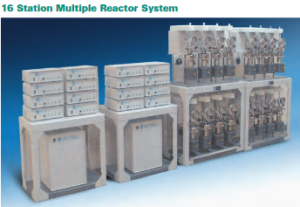 |
16 Station Multiple Reactor System is a combination of sixteen standard 4560 Mini Reactors with heaters, valves, pressure gages and rupture disc assemblies and two 4871 Process Controllers with sixteen 4875 Power Controllers. It allows the user to run multiple reactions simultaneously, applying the principles of high-throughput experimentation. Individual variables that can be controlled are gas mixtures, liquids, catalysts or other solids, stirring speed, temperature, pressure and time. |
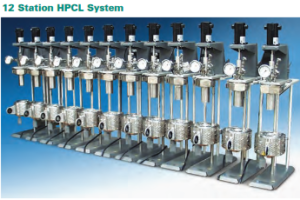 |
12 Station HPCL system makes use of the lower cost 5500 High Pressure Compact Lab Reactors that feature a modified stand, aluminum block heaters, removable vessels and a standard gage block assembly. A control system (not pictured) automates the process, monitors the parameters and collects the data. |
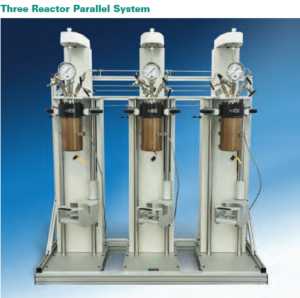 |
Three Reactor Parallel system incorporates three 1.8 L 4570 Series High Pressure/ High Temperature reactors rated for use at 5000 psi (345 bar) @500 °C. The reactors in this system are manufacatured of Alloy C-276 and are equipped with internal coupon holders to facilitate study of corrosion processes in harsh environments. This application does not require precisely controlled gas delivery; hence individual gas feed vessels are not present, though gas supply and gas vent manifolds are provided. A 4871 Process Controller is also included (not shown) |
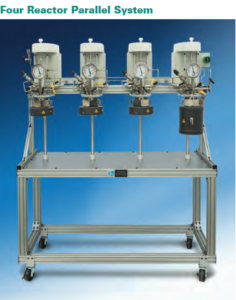 |
Four Reactor Parallel system consists of three 160 mL and one 450 mL 4560 Series Reactors rated for use at 3000 psi (200 bar) @ 350 °C. This configuration allows both high throughput screening and scale-up, if desired. Gas supply and vent manifolds for the entire system and pressure control for the larger reactor are provided. Reactor temperatures and stirring speed are controlled by four 4848 Reactor controllers (not shown). |
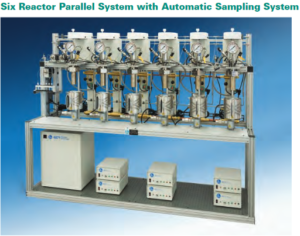 |
Six Reactor Parallel system with automatic sampling system includes six 25 mL, 4590 Series Stirred Micro Reactors rated for use up to 3000psi (200 bar) @ 350 °C. Gas supply and vent manifolds are provided, as well as manifolds to deliver and drain cooling water to/from either the internal cold finger or the external aluminum block heaters with cooling channels. Note the automated liquid sampling system present on the reactor on the left. This sampling system allows the sequential collection of several ~1 mL liquid samples under full reactor operating pressure, and automatically clears the liquid sampling lines between samples. Control is provided by a 4871 Process Controller |























